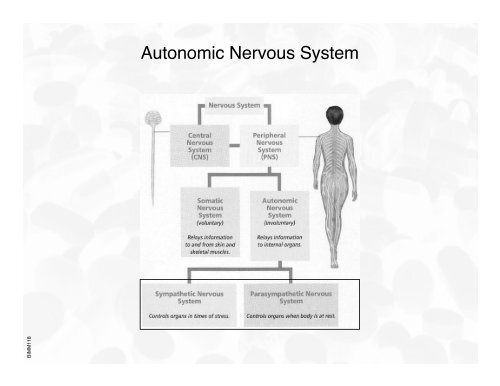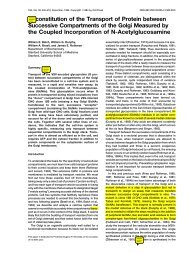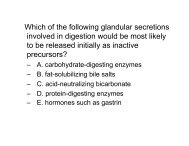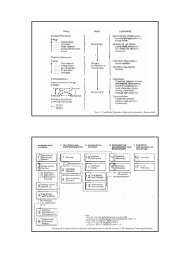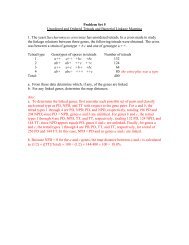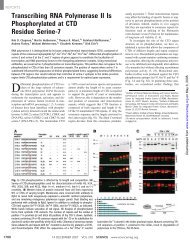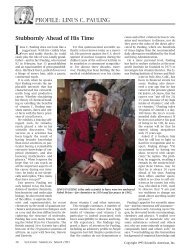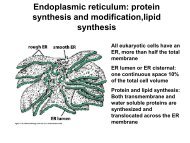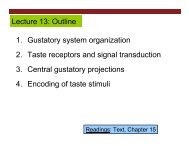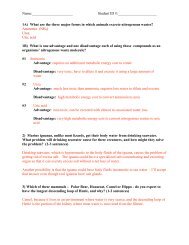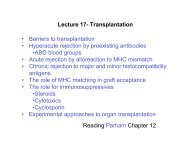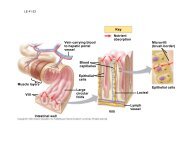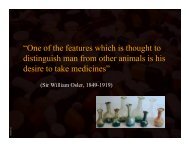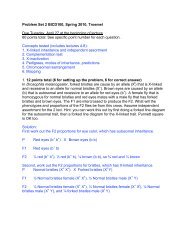Autonomic Nervous System
Autonomic Nervous System
Autonomic Nervous System
You also want an ePaper? Increase the reach of your titles
YUMPU automatically turns print PDFs into web optimized ePapers that Google loves.
BIMM118<br />
<strong>Autonomic</strong> <strong>Nervous</strong> <strong>System</strong>
BIMM118<br />
<strong>Autonomic</strong> <strong>Nervous</strong> <strong>System</strong>
BIMM118<br />
• Ganglia close to the<br />
innervated organs<br />
• Myelinated axons<br />
• Note:<br />
Somatic nervous<br />
system has no<br />
ganglia!<br />
<strong>Autonomic</strong> <strong>Nervous</strong> <strong>System</strong><br />
• Ganglia close to the<br />
spinal column<br />
• Preganglionic axons<br />
are myelinated;<br />
postganglionic axons<br />
are unmyelinated
BIMM118<br />
Transmitters:<br />
• Acetylcholine:<br />
<strong>Autonomic</strong> <strong>Nervous</strong> <strong>System</strong><br />
– ALL preganglionic neurons<br />
– ALL parasympathetic postganglionic neurons<br />
• Norepinephrine (= Noradrenalin):<br />
– MOST sympathetic postganglionic neurons<br />
– Exceptions: Sweat glands (Acetylcholine);<br />
Renal arteries (Dopamine)<br />
• Epinephrine (= Adrenalin):<br />
– Adrenal medulla upon sympathetic impulses<br />
(no ganglion!)
BIMM118<br />
Receptors:<br />
• Cholinergic Receptors:<br />
<strong>Autonomic</strong> <strong>Nervous</strong> <strong>System</strong><br />
– Muscarinic (M): at the target organ<br />
named after activation by Muscarine<br />
(poison of Amanita muscaria)<br />
– Nicotinic (N):<br />
ganglia, motor endplate, medulla<br />
named after activation by Nicotine<br />
• Adrenergic Receptors:<br />
– α, β − receptors
BIMM118<br />
Cholinergic receptors:<br />
• Muscarinic receptors:<br />
Hetrotrimeric G protein-coupled<br />
– CNS, gastric mucosa: M1<br />
– Cardiac: M2<br />
– Glandular/Smooth muscle: M3<br />
• Nicotinic receptors:<br />
Ion channel-coupled<br />
– Muscle type (motor endplate)<br />
– Ganglion type<br />
– CNS type<br />
Cholinergic <strong>System</strong><br />
Acetylcholine is rapidly hydrolyzed by a membrane-associated<br />
Acetylcholinesterase in the synaptic cleft
BIMM118<br />
Cholinergic <strong>System</strong> - Agonists<br />
= Cholinomimetics = Parasympathomimetics<br />
Two main classes:<br />
• Direct Parasympathomimetics:<br />
– Have affinity for M (and/or N receptors) => mimic AcCholine<br />
– Act mostly on the M type receptors (not subtype selective)<br />
Exception: Nicotine, (Muscle N type only: Tubocurarine,<br />
Succinylcholine)<br />
• Indirect Parasympathomimetics :<br />
– Inhibit the activity of Acetylcholinesterase => [AcCholine] increased
BIMM118<br />
Cholinergic <strong>System</strong> - Agonists<br />
Muscarinic Parasympathomimetics<br />
The extremely short half-life of AcCholine<br />
makes it therapeutically useless =><br />
• Carbachol:<br />
– Not hydrolyzed by AcCholinesterase<br />
– Also activates N receptors<br />
• Bethanechol:<br />
– Not hydrolyzed by AcCholinesterase<br />
– Does not activate N receptors<br />
– Lacks cardiovascular effects<br />
– Treatment of urinary retention<br />
Bethanechol
BIMM118<br />
Cholinergic <strong>System</strong> - Agonists<br />
Muscarinic<br />
Parasympathomimetics<br />
Pilocarpine:<br />
– Chief alkaloid in Pilocarpus jaborandi<br />
– Does not activate N receptors<br />
– Used to treat glaucoma<br />
Ciliary muscle contraction=>increased outflow<br />
of aqueous humor => reduction in intraocular<br />
pressure<br />
• Muscarine:<br />
– Chief alkaloid in Amanita muscaria<br />
– No therapeutic application
BIMM118<br />
Cholinergic <strong>System</strong> - Agonists<br />
Acetylcholinesterase Inhibitors<br />
=> Extend half-life of AcCholine => trigger activation of both M and N receptors
BIMM118<br />
Cholinergic <strong>System</strong> - Agonists<br />
Acetylcholinesterase Inhibitors<br />
Reversible Inhibitors:<br />
Used to treat Glaucoma (topical) and<br />
Myasthenia Gravis (systemic)<br />
• Carbamates:<br />
– Physostigmine (only topical)<br />
from Physostigma venenosum<br />
(= Calabar bean; West Africa)<br />
– Neostigmine<br />
• Quarternary alcohols:<br />
– Edrophonium<br />
Used to diagnose Myasthenia Gravis<br />
(very short half-life)
BIMM118<br />
Cholinergic <strong>System</strong> - Agonists<br />
Acetylcholinesterase Inhibitors<br />
• “Horny goat weed”<br />
– Epimedium sagittatum<br />
– Acts as AcCh-esterase inhibitor (active ingredient unknown)<br />
– Indirect stimulation of vascular M3 receptors triggers NO production => vasodilation<br />
(action similar to Sildenafil (Viagra®), which potentiates NO effects)
BIMM118<br />
Cholinergic <strong>System</strong> - Agonists<br />
Acetylcholinesterase Inhibitors<br />
Irreversible Inhibitors:<br />
No medical application!<br />
• Organophosphates:<br />
– Insecticides<br />
• Malathion<br />
• Parathion<br />
– Nerve gases<br />
• Sarin<br />
• Tabun<br />
• Soman
BIMM118<br />
Cholinergic <strong>System</strong> - Antagonists<br />
= Cholinolytics = Parasympatholytics<br />
• Muscarinic receptor blockers:<br />
– Competitive antagonists<br />
– Widespread medical applications:<br />
• Inhibition of bronchial and gastric secretion<br />
• Relaxation of smooth muscles (Bronchii, pupillary sphincter…)<br />
• Cardioacceleration<br />
• CNS-altering effects<br />
• Nicotinic receptor blockers:<br />
– Ganglion-specific blockers: no clinical applications<br />
– Neuromuscular blockers: Muscle relaxants
BIMM118<br />
Cholinergic <strong>System</strong> - Antagonists<br />
Muscarinic Parasympatholytics<br />
Atropine<br />
Chief alkaloid in Atropa belladonna: CNS-stimulant (leaves were used as “asthma cigarettes”)<br />
Hyoscine (=Scopolamine)<br />
Chief alkaloid in Datura stramonium: CNS-depressant => antiemetic (motion sickness)
BIMM118<br />
Cholinergic <strong>System</strong> - Antagonists<br />
Muscarinic Parasympatholytics<br />
Clinical applications:<br />
• Atropine:<br />
– before anesthesia: prevent hypersecretion of bronchial mucus<br />
– Bradycardy<br />
– Acetylcholinesterase-inhibitor and mushroom poisoning<br />
– Ophtalmology (eye exams)<br />
• Scopolamine:<br />
– Motion sickness (as patches)<br />
• Ipratropium:<br />
– Inhalation for asthma and bronchitis<br />
• Pirenzepine:<br />
– Peptic ulcers: selectively inhibits M1 receptors (gastric mucosa) =><br />
reduced gastric acid production<br />
• N-Butyl-scopolamine:<br />
– Spasmolytic (intestinal or menstrual cramps)
BIMM118<br />
Cholinergic <strong>System</strong> - Antagonists<br />
Nicotinic Parasympatholytics<br />
Two classes (both act as neuromuscular blockers => muscle relaxants):<br />
• Competitive antagonists = Nondepolarizing blockers<br />
– Act by competing with AcCh for binding to the N receptors<br />
– Prevent depolarization of the endplate<br />
– Action can be reversed by increasing AcCh concentrations (e.g. via AcCh-esterase inhibitors)<br />
• Agonists = Depolarizing blockers<br />
– AcCh mimetics that are not hydrolyzed by AcCh-esterase (but hydrolyzed by plasma esterases)<br />
– Act by triggering a sustained depolarization of the neuromuscular endplate<br />
– No new action potential can be generated<br />
– Can NOT be reversed increasing AcCh concentrations (would cause further depolarization)
BIMM118<br />
Cholinergic <strong>System</strong> - Antagonists<br />
Nicotinic Parasympatholytics<br />
Nondepolarizing blockers<br />
• Curare:<br />
– Plant derived arrow poison in S-America<br />
– Active ingredient is d-Tubocurarine<br />
– Death occurs through respiratory paralysis<br />
– Tubocurarine is not absorbed orally => no risk eating the prey<br />
– Tubocurarine was used clinically as muscle relaxant during surgery<br />
but: Tubocurarine triggers histamine release => blood pressure drops
BIMM118<br />
Cholinergic <strong>System</strong> - Antagonists<br />
Nicotinic Parasympatholytics<br />
Nondepolarizing blockers<br />
Synthetic quarternary ammonium compounds<br />
– Replaced tubocurarine as muscle relaxants<br />
– No or little histamine release<br />
• Pancuronium long-lasting action (1-2h)<br />
Used in lethal injection (together with barbiturate + KCl)<br />
• Vecuronium intermediate-lasting action (
BIMM118<br />
Cholinergic <strong>System</strong> - Antagonists<br />
Nicotinic Parasympatholytics<br />
Depolarizing blockers<br />
• Succinylcholine = Suxamethonium<br />
– “dimeric” Acetylcholine<br />
– Acts agonistic like AcCh<br />
– NOT hydrolyzed by AcCh-esterase (only by plasmaesterases)<br />
– Initial depolarization triggers muscle twitching<br />
– Followed by persistant depolarization (~10min)<br />
– Used for brief procedures (e.g. intubation; shock therapy)
BIMM118<br />
Cholinergic <strong>System</strong><br />
Parasympathetic Drugs - Summary


